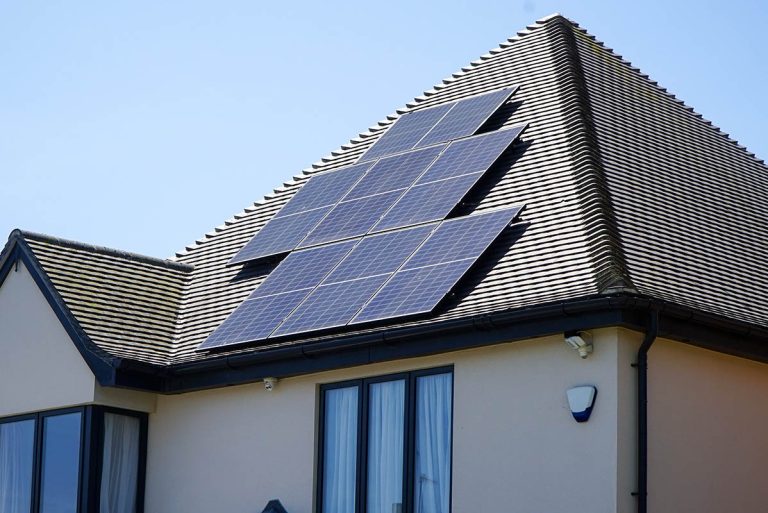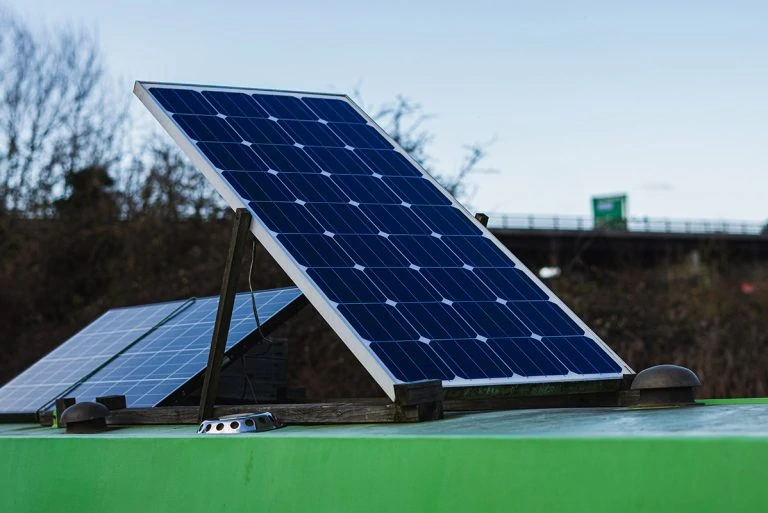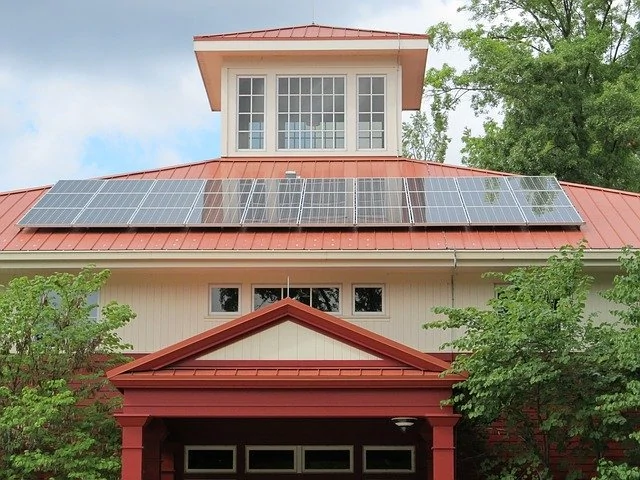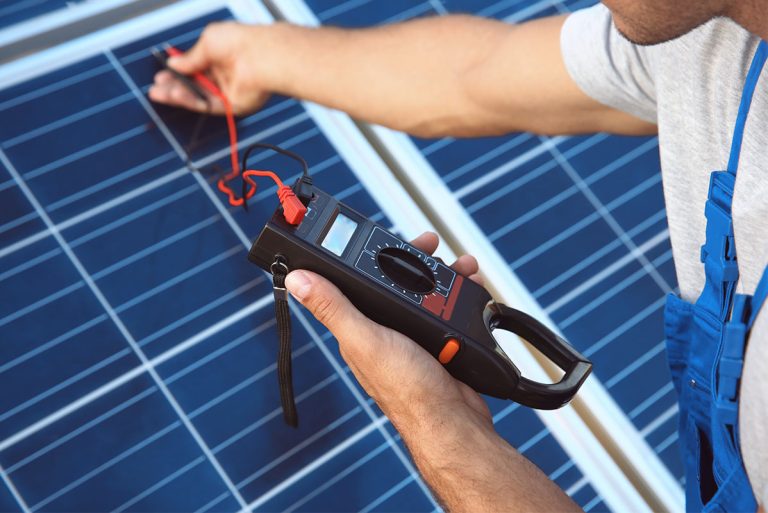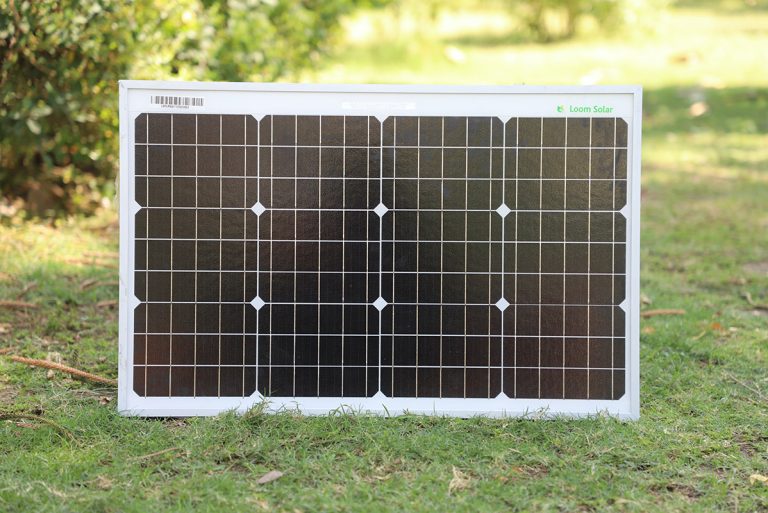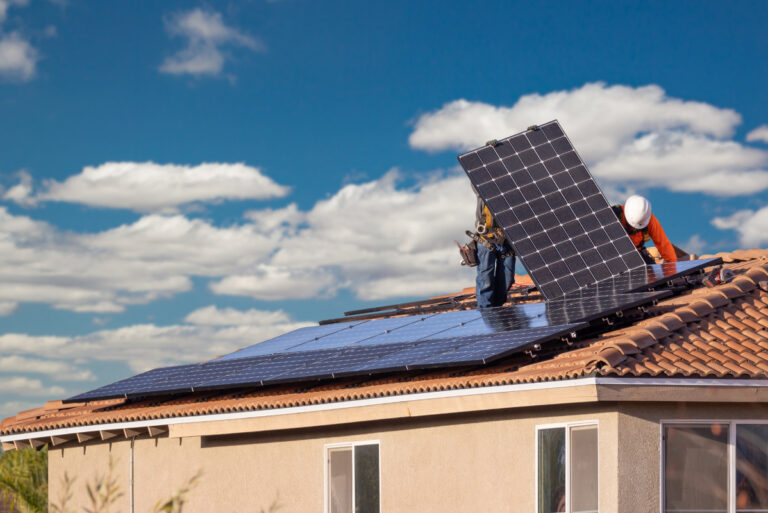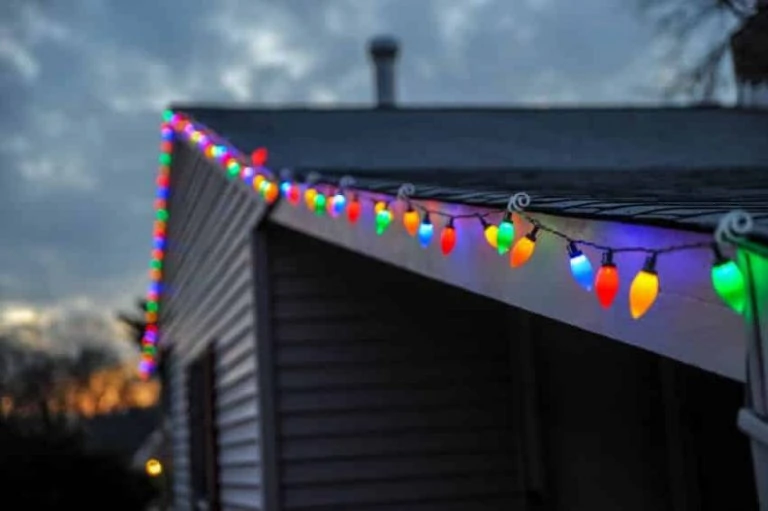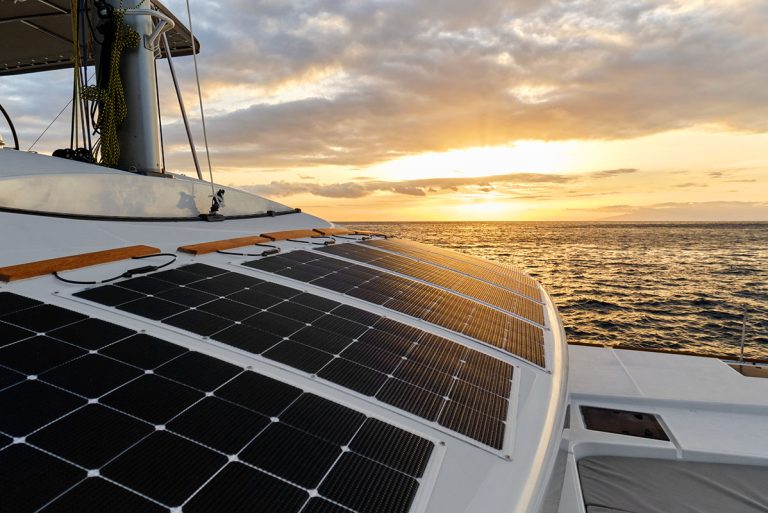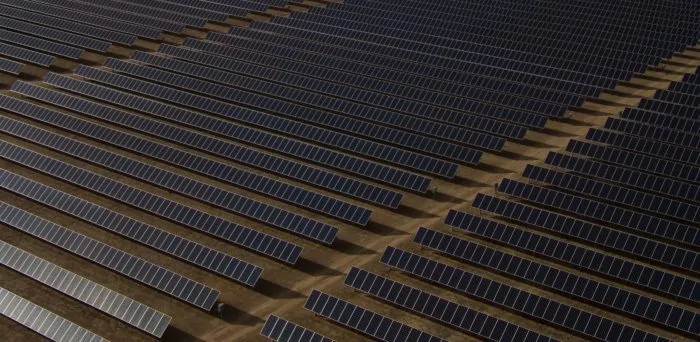The price of a residential solar system has fallen by a whopping 64% since 2010. And yet, clean energy is still a major home improvement investment.
So, naturally, you want to know how long solar panels last before you take the plunge.
Here in our solar panel lifespan guide, you’ll find out everything you need to know about how long solar panels last.
Fortunately for budget-conscious homeowners, there are many ways — both before and after purchasing a rooftop or ground mounted solar array — that you can extend your solar panel lifespan.
Get the full scoop here on the average solar panel lifespan and how to make your solar panels last longer.
How long do solar panels last? Average solar panel lifespan
The best indicators for determining how long solar panels last are the performance and the product (materials/workmanship) warranties that solar manufacturers offer when you purchase their photovoltaic (PV) panels.
These documents represent the manufacturer’s promise regarding the power output and quality of their solar panels over time. The warranties protect homeowners from receiving PV panels that don’t generate as much energy as they claim to, or are defective in any way.
Until this year, the standard performance warranty offered by top tier solar module makers was a guarantee of 25 years of energy production at 80% or higher of their stated output.
The product (in terms of materials and workmanship) warranty was a guarantee for 10 years in most cases.
Sample calculation for a solar panel lifespan
As an example of how you use warranty information to figure out how long a solar panel lasts, consider a typical residential PV panel rated at 300 watts (W).
According to a standard solar panel performance warranty, a 300W solar panel is guaranteed to produce at least 300W x 0.80 = 240W at 25 years post-installation. (80% = 0.8.) If it under performs while the warranty is in force, you’d be eligible for a replacement.
Likewise, if a panel developed microcracks in its third year, even those barely perceptible to the naked eye but enough to reduce energy production, you would be eligible (in theory, at least) for a free repair or replacement.
While these are still the warranty parameters followed by the majority of solar manufacturers today regarding the best way to know how long solar panels last, one solar company raised the bar concerning how long solar panels last in 2022.
SunPower and the 40-year solar panel warranty
In the beginning of 2022, solar giant SunPower announced a 40-year warranty on their Maxeon Interdigitated Back Contact (IBC) panels in select countries including UK, France, Germany, Australia, Mexico, and Japan.
At the time of this writing, United States residents are not eligible for the 40-year performance warranty by SunPower. For them, the customary 25-year performance warranty is offered.

Source: SunPower
SunPower’s IBC modules are high-performing because of advanced technology that eliminates traditional, front-side metal ribbons through which electrical energy moves on its way inside your house. IBC panels situate these ribbons on the back where sunlight interference isn’t an issue (except on bifacial solar panels).
So, the front sides of IBC modules offer more surface area for sun exposure, unhindered by metal ribbons running throughout. Consequently, they produce more energy than their counterparts with customary and widespread metal ribbons over the panel’s face.
SunPower’s 40-year warranty includes these features:
- Minimum power output of 98% of panel’s wattage rating in the first year
- Maximum panel degradation of 0.25% per year for the following 39 years
- Workmanship and materials covered
- Servicing needed to repair, replace, or refund defective panels
After calculation, this means there is 88.3% guaranteed power output at the end of 40 years. (See the next section for more information on degradation rate and how to calculate estimated power output using it.)
So, these top-performing solar panels can continue to generate 80%+ of their stated output well after 40 years of use. What an attractive proposition for energy-conscious homeowners!
What happens if my solar company goes out of business before my warranty expires?
If your solar panels last longer than the company that installed them, but a problem normally covered by their warranty arises, you are out of luck — unless the company made other arrangements to cover the warranties of its existing customers.
But don’t count on it.
Fortunately, it’s possible to insure your residential solar system with an independent insurer to avoid a potential catastrophe like a bankrupt solar company just when you needed them.
In fact, you will receive a new warranty longer and more comprehensive than the original from the now-defunct solar installer.
Be sure to read the fine print before signing on, though. Only select solar module and inverter manufacturers are covered.
What is solar panel degradation?
Solar panels undergo several natural degradation processes by which their power performance drops over time and which shortens the average solar panel lifespan. These include:
- LID: Light-induced degradation (from initial and continuous exposure to sun)
- PID: Potential-induced degradation (due to voltage leakage)
- LeTID: Light- and elevated temperature-induced degradation (poorly understood but distinct from LID)
- Microcracks (physical damage)
- Hotspots (localized overheating)
- Panel deterioration or malfunction (front and/or back, due to water penetration or corrosion)
- Discoloration (weather effects)
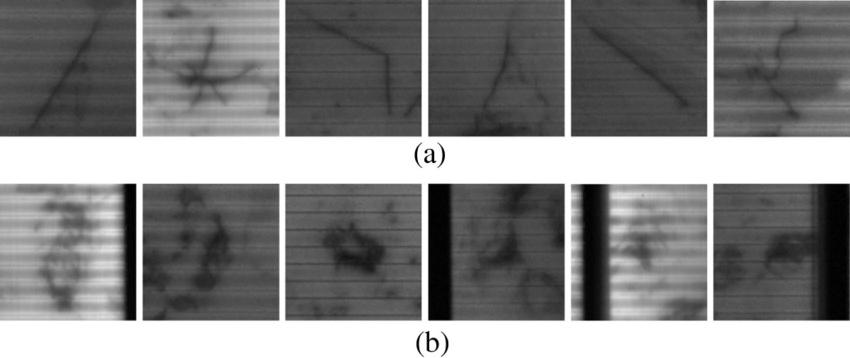
Source: ResearchGate
Most of these degradation effects usually occur slowly over time. When not corrected early, they will get progressively worse, potentially resulting in huge power losses.
LID, however, usually results in a 2-3% power loss immediately after a solar array goes live for the first time and lasts for several days until the degradation rate is stabilized, typically below 1%.
In the factory, manufacturers may compensate for expected light-induced degradation by increasing the actual power output of its panels by about 5% above what the panels’ spec sheet rating is. But, due to continued LID over the modules’ lifetime, the output won’t stay elevated for very long.
LeTID, on the other hand, could occur suddenly and result in an approximately 10% loss in power performance.
Tips on how to estimate a solar panel lifespan: degradation
Top-of-the-line solar panels suffer less degradation than inferior panels. In general, the more expensive a solar module is, the lower its degradation rate.
But to be sure, always check the panel’s specification sheet for expected degradation rates when comparison shopping for PV panels.
Before buying, ask your prospective solar company for data on degradation for the PV modules you’re considering, including data based on real homeowner experiences.
What is a solar panel degradation rate?
According to the National Renewable Energy Laboratory, the average solar panel degradation rate is 0.5% per year. This value reflects the amount of expected power loss each year by the PV modules because of normal deterioration.
It’s an average percentage meaning it could be slightly higher or lower. A degradation rate of 1% is possible for low-quality, inexpensive PV panels.
As a rule of thumb, the degradation rate is usually higher than the average 0.5% in hotter climates and in rooftop systems vs. ground mount PV arrays.
For certain types of degradation, such as light-induced degradation (or LID), the power loss may be substantial only in the beginning when your PV system goes live, then taper off in the following years.
Each year, most solar panels lose a small amount of output capacity by comparison with the previous year. In most cases, high-quality PV panels don’t suffer as much degradation as their inferior competitors over their lifespan.
Sample calculation: Effect of solar panel degradation rate on power performance
As an example, consider a small 5 kW rooftop solar system. Assume that the panels degrade at 0.5% per year (0.5% = 0.005).
This means — ideally on a cool day with 5 hours or more of direct sun — your 5 kW solar system can produce approximately 5,000 watts (5 kW) of electricity every hour (1 kW = 1,000 W).
At peak functioning for 5 hours, that’s the equivalent of 25,000 Wh per day (25 kWh).
So in one year, your 5 kW system yields 25 kWh/day x 365 days = 9,125 kWh (rounded down to 9,000 kWh for the rest of this example for ease of calculation).
Note: In reality, your solar array will not perform at its peak every day due to weather fluctuations. This example assumes for the purposes of illustration that it will.
At the end of your array’s first year, accounting for initial light-induced degradation (LID) of 2% (see previous section):
Output capacity: 9,000 kWh
Degradation loss: 9,000 kWh x 0.02 = 180 kWh; [2% = 0.02].
So, your system’s baseline output capacity is no longer 9,000 kWh per year at the end of year 1.
Due to LID at the start of operation, it becomes 9,000-180 = 8,820 kWh. This is what it can produce when functioning at peak level in the beginning of the system’s second year.
Then, repeating this calculation for the second year using the average degradation rate of 0.5%, you get a little bit more degradation:
Starting output capacity: 8,820 kWh
Degradation loss: 8,820 kWh x 0.005 = 44.1 kWh
Thus, you begin the third year of energy production with 8,820 – 44.1 = 8,776 kWh as the maximum possible for solar energy production.
The calculations repeat for each year as shown.
For this example, after 25 years (the end of most warranties), with a 0.5% degradation rate each year after accounting for an initial LID loss of 2% in the first year, these calculations terminate with an approximate 12% loss of initial, theoretical maximum power performance of 9,125 kWh.
Put another way, after 25 years, your solar panels will retain about 88% (100-12%) of their original output capacity when their degradation rate is the industry’s current average of 0.5% per year.
That’s still a very high level of energy production after a quarter century of use!
Fortunately, no extreme power degradation is expected after that — unless there’s a bizarre weather event.
But even if there is extreme weather in your area, your solar panels may still last longer — unlike your roof — as the photo below illustrates.

Roofs have substantial damage but modules appear for the most part undamaged.
Source: National Renewable Energy Laboratory
Your solar panels will never suddenly turn off at the 25- (or 40-) year mark when their warranty expires. They will last longer than that.
At that mark, they will just produce less energy compared to earlier years of operation. In cases of good-to-high quality PV panels, the energy drop is around 88% of what it was when you first turned your system on.
How do you know when it’s time to replace “spent” solar panels?
The solar industry states that solar panels are considered “spent” when they’re at the end of their warranty coverage period or producing less than 80% of the energy output they had in their first year of operation.
Because some solar companies are offering 30- or 40-year warranties on their PV panels, there is no need to replace or discard your solar array even after 40 years unless your energy needs have significantly increased by more than 20% of what they were when you had initially installed your solar system.
The reason for this recommendation is that although solar modules will lose a small portion of power performance during the warranty period due to normal degradation, it will likely never fall under 80% of their stated wattage by the warranty’s end.
The sample calculation in the previous section, based on a 25-year warranty, showed this to be true.
Expressed another way, for homeowners with typical 200W to 400W panels, this means you’ll still get at least 160W to 320W from each panel, respectively, at warranty’s end, barring freak accidents or a faulty inverter.
200W x 0.8 = 160W. 400W x 0.8 = 320W; 80% = 0.8.
The same rule of thumb applies no matter the length of the warranty (25 years is most common).
This rule also doesn’t depend on the size of your solar system (in terms of wattage or in terms of the number of PV modules).
The good news, as you’ve seen in the preceding section, is that solar panels will continue to create electricity — although at a reduced level — even after their warranty expires.
By using a solar performance monitoring system such as Solar Analytics, you’ll be able to tell at a glance (or a phone swipe) how well your panels are generating electricity for you over time.
If you’re still at 80% power performance 10, 20, or 30 years post-warranty expiration, then there certainly is no need for a new solar installation. This is true especially if your original solar installation was larger than needed to compensate for potential production loss due to cloudy or snowy days when energy output will be sub-optimal.
Furthermore, if your energy needs have dropped after 40+ years — for example, due to becoming an empty nester once your grown children move out — your original solar system may meet your reduced demands even if it’s functioning only at 75% capacity.
Is solar panel recycling common in the United States?
Unfortunately, solar panel recycling is not common in the United States today.
Currently in the United States, 90% of used (spent) solar panels are landfilled. That amounts to 50,000 still-functional PV panels every day! As you’ve seen from the sample calculations above, this represents an enormous quantity of energy…thrown away.
Discarding PV modules that retain significant electricity-generating capacity is not an example of a good human-environment interaction, especially if you’re striving to live a zero-waste, sustainable lifestyle.
Plus, it’s a huge amount of bulky solid waste with numerous hazardous components.
Fortunately, there is active research into solar panel recycling today. It just hasn’t become widely utilized commercially yet.
3 ways to reuse spent solar panels
When you decide it’s time to make a change in how you produce solar energy at home — whether it’s 30 or 50 years after first installing rooftop solar — you have several options for dealing with the spent solar panels.
You may wish to:
- Enlarge your existing solar array by adding new panels to make up for the natural energy loss due to degradation of your original installation.
- Donate the spent panels to an organization that will install them elsewhere to offset energy costs for a qualified family or business.
- Recycle them (although this is not yet common practice in the United States and so it may not be readily accessible to you).
Do solar inverters or microinverters last as long as solar panels?
The “brains” of your residential solar array is the solar inverter (also called a string or central inverter) located on the ground level of your home (inside or out), or the microinverters situated under or close to the solar modules in the solar array.
These devices are responsible for converting the DC electric current that the solar cells in the solar panels create from sunlight to AC current that’s used by most appliances in your home.

If your solar system is connected to the public utility grid or to a battery backup for storage, the inverter will channel excess electricity your array produces to one, the other, or to both.
Most solar inverters on the market today are warranted for an average of 10 years. Some inverter companies offer warranty extensions.
Today, microinverters may have longer warranties, even equal to those of solar panels (25 years). However, be sure to read the warranty fine print. It may not cover everything, such as the wall or communications equipment, for the same length of time.
Do solar panels last longer than solar inverters?
Most solar inverters are warranted for a shorter time compared to the PV panels. Predictably, most solar system failures occur with the inverter as the following graph shows:

So, since the lifespan of solar panels is often more than twice that of your inverter, plan on replacing the inverter once, twice, or even more for your array. It depends on the length of time past your PV panel’s warranty expiration that you wish to benefit from their reduced energy performance.
When you need a new inverter, it’s the perfect time to consider switching to microinverters and/or power optimizers if you’re thinking about it.
Note that research shows that both central and microinverters perform similarly in terms of power performance despite widely accepted claims that microinverters operate better.
3 ways to extend solar panel lifespan
Solar panels do not have moving parts. This means it’s easier (and cheaper) to make them last longer compared to wind turbines.
There are three key ways to maximize the longevity of solar panels and ensure that they’re producing as much energy as they should be.
1. Solar panel performance monitoring
Even though you cannot see your solar panels actually converting solar rays to electrical energy by looking at them, it’s possible to verify that they’re functioning correctly.
You can do this by monitoring their energy output in real time through an app on your phone or a program on your laptop.
Solar inverter manufacturers usually provide this capability when you purchase their products. Your solar installer will get you connected at the time your solar system goes live.
With the right setup, you can monitor a PV system remotely when you’re away from home.
Here’s a sample graph that an app or web portal generates so you can monitor solar panel power performance over time:

When connected to the internet, the data can be sent to the solar company that installed them.
If there’s a drop in production over time, or a change in any given month compared to the same time in previous years, your solar company can alert you. Scheduling an appointment to troubleshoot the issue will rectify the situation to prevent further performance loss.
2. Solar panel cleaning
Proper cleaning can help to extend solar panel lifespan. There are professional solar panel cleaning companies ready to assist you on a regular basis. This service can be expensive.
Fortunately for budget-conscious homeowners, solar panel cleaning may not be necessary.
If you’re in an area that receives regular rainfall, solar panel cleaning is not needed.
On the other hand, if you’re in a drought-prone area with heavy urban air pollution, frequent dust storms, or prolonged wildfires, it will be necessary to clean your solar panels often.
When covered by dirt and debris, solar modules will suffer major performance setbacks.
Using a low-pressure garden hose — never a high-pressure power wash — is sufficient. Gently wiping them down with a soft cloth that doesn’t leave tiny bits of material behind is optional.
However, if your water is hard, (i.e., contains a large amount of minerals), using distilled water is preferable. This way, you’ll avoid leaving mineral deposits on the glass surface that impede sun ray penetration to the solar cells under the glass where electricity is created.
Similarly, if you live by the ocean, periodically remove the salt deposits from ocean mist that dries on the solar panels.
Research is underway to develop self-cleaning solar panels, saving you both time and money.
3. Professional solar panel assessment
With many communities experiencing extreme weather events worsened by our climate crisis, it’s prudent to schedule a solar panel inspection post-storm, especially if your performance software indicates a problem.
Qualified solar technicians will be able to check for damage and perform emergency repairs or replacements.
Hopefully, when done quickly, you won’t suffer too much loss of solar power production.
When a solar panel service call is needed, and when it’s not
In cases where your solar power monitoring data look normal after an extreme storm with gusty winds or hail, you may still wish to schedule an assessment.
Tiny microfractures or loosened electrical connections could have occurred. Without a rapid fix, these issues could worsen over time and require a major repair later.
On the other hand, your monitoring system could suggest there’s a serious problem when there really is none. Sudden drops in energy output could be caused by your inverter — not your solar panels.
We’re not referring to a utility grid power outage that will also shut down your solar array. (At times like that, you’d wish you had a solar battery backup for storage!)
Solar inverters have undergone technological improvements making them extremely sensitive to all electrical disturbances that are out of the ordinary.
These events may result in a temporary shutdown of your solar system. This often occurs when an inverter detects utility grid surges during high-usage times (like a heatwave).
When this happens, you’ll see a momentary drop in power performance. It will resolve itself once the grid returns to normal.
If you notice this, give it 12-24 hours before calling a solar technician. Then do so only if the problem persists.
You’ll save a lot of money and avoid an expensive service call for nothing. 😉
Ways to increase energy production from your solar panels
Sometimes, people asking about solar panel lifespan really want to know how they can optimize their solar panels to increase energy production for as long as possible.
There are several characteristics of solar panels to take into account when you wish to get the most energy from them for the longest possible time.
1. Low degradation rate
The degradation rate discussed earlier is an important metric to judge how long solar panels last. Choose panels that have a degradation rate of 0.5%/yr. or less.
2. High-efficiency solar panels
In order to limit the effect of degradation rate on energy production, purchase high-efficiency panels. These often have the lowest degradation rates on the market. They are also the most expensive modules you can buy.
The good news for consumers is that the price of solar modules has plummeted by 99.6% since the 1970s with no end in sight.

Monocrystalline solar panels are the most efficient solar panels available today for homes, as well as the most expensive. Their efficiencies may be as high as 23-24%.
3. Low temperature coefficient
High-efficiency solar panels are very good at converting sunlight to electricity. Their low temperature coefficients (available on the spec sheet) is part of the reason why.
This means they do not experience significant drops in energy output when it’s hot outside like poorer quality solar panels do.
Tip: Be sure your installer leaves 2-3 inches between your roof surface and the metal racking securing your PV array in place. This space will permit airflow under the panels, cooling them off. To ensure the highest power performance, it’s important to keep the panels as cool as possible.
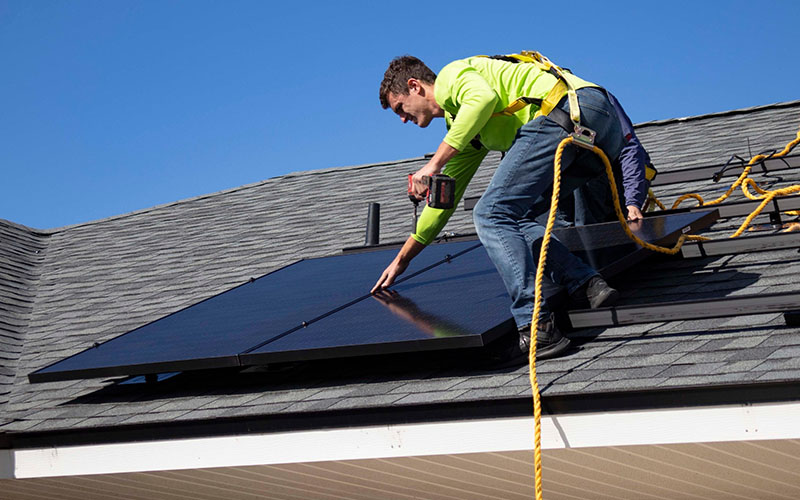
Research is underway to develop self-cooling solar panels, making it even easier to decrease power loss due to elevated ambient temperature.
Once you’ve decided on high-efficiency solar panels with a low degradation rate and a low temperature coefficient, there are still other ways you can optimize energy production for as long as the power warranty lasts — and beyond (see #4 below.)
4. Setting up solar panels for optimal energy production
To get the most energy from solar panels for as long as possible, their placement angle and orientation in relation to the sun are critical.
Facing due south
Ideally, arrange your solar panels so that they are directly in front of the sun when the sun is at its highest point in the sky. This orientation corresponds to an azimuth angle of 180 degrees.

If your roof is not south-facing, a ground mounted system may work better for you. You’d be able to set up a solar array facing due south (space permitting) on your property.
Avoid solar panel shading
Both trees and buildings could block all or part of your PV panels at some point during the sun’s trajectory in the sky each day.
Microinverters will minimize this issue.
Use the optimal solar panel tilt angle
The manner in which your solar panels are tilted in relation to the sun is important in increasing the power production of your solar panels. This is known as the tilt (elevation) angle.
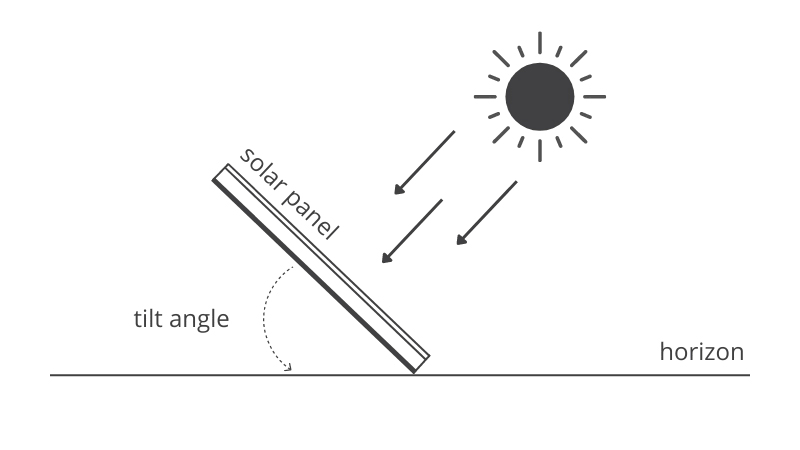
Ideally, you want your solar panels to receive incoming solar rays directly perpendicular to your PV modules for maximum energy production.
For solar panels that are stationary (do not track the sun), it is common to hear that a tilt angle of 15 degrees added to your latitude in winter or subtracted from your latitude in summer, or simply an angle equal to your latitude, is the best for optimal power performance from solar panels.
This advice is too general and won’t result in a solar setup optimized for peak power performance all year long.
According to Charles Landau who has done extensive research on optimum tilt angles for solar panels, the best tilt angle for fixed rooftop solar can be found by calculating:
- If your latitude is below 25°, use the latitude times 0.87.
- If your latitude is between 25° and 50°, use the latitude, times 0.76, plus 3.1 degrees.
Homeowners with ground mount systems have more flexibility. They also have a greater ability to optimize their array’s tilt angles at any time. They may adjust the tilt angle to correspond with the seasons as the position of the sun in the sky changes over the course of a calendar year.
For people who are restricted to having just one tilt angle for their rooftop solar system, choose the one for the season where your energy needs are greatest (or most costly, depending on where you live).
Use the PVWatts calculator by the National Renewable Energy Laboratory to find out precisely what the optimal tilt angle is for your solar array at a given time during the year.
Highlights on solar panel lifespan
It’s easier to see a quicker return on investment on your rooftop solar system by investing in solar panels that possess:
- High efficiency
- Low degradation rate
- Low temperature coefficient
Solar panels that possess these superior characteristics come with the longest performance and product (materials) warranties available today.
Forty years (with 80%+ performance) is the latest warranty length for PV panels. Twenty-five years is standard.
It’s also important to set up your solar modules in a way that maximizes their energy production, no matter their starting efficiency.
To succeed, set up your array (rooftop or ground mount) so that solar modules:
- Are facing due south
- Have a tilt angle appropriate for your location
- Use a high-quality inverter (or microinverters) for DC to AC current conversion
During their lifespan, you can ensure best performance of your solar modules by:
- Monitoring energy production in real time through an app
- Cleaning them when needed
- Checking their condition after heavy storms by hiring a solar company to assess their condition
When you follow the recommendations given above, it’s likely that your solar panels will last longer than their warranties claim they will.
They will produce clean energy to meet some or all of your home energy needs for many years — even decades — longer than you had imagined they ever could.
